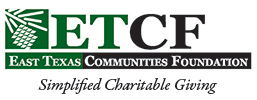One of the headlines in the Oct. 27 issue of the Chronicle of Philanthropy was “Fidelity Overtakes United Way as New Charity Champion.”
The article was reporting on the Chronicle’s annual ranking of the Top 400 charities in the United States, based on contributions received in the prior year. This documents an interesting shift that has taken place in philanthropy since Fidelity Investments began offering donor-advised funds 25 years ago. DAFs have been gaining rapidly in popularity, driven in large measure by how simple they are to use. Pamela Norley, president of Fidelity Charitable, was quoted as saying about DAFs, “It’s an intermediary between the donor and charity that allows the process of giving to be simpler and more transparent and easier for record-keeping.” DAFs must be doing something right because three of the top 10 charities in the Philanthropy 400 list are DAF sponsors – Fidelity Charitable Gift Fund, Schwab Charitable and National Christian Foundation.
East Texas Communities Foundation offers seven types of charitable funds to meet the needs of individual donors, nonprofit organizations, corporations and giving circles of all shapes and sizes. The most popular funds are DAFs. In the last 13 years, the number of DAFs at ETCF has doubled, as has the value of the assets managed for those funds. Not only are DAFs popular, accounting for nearly one-third of the funds managed by ETCF, but they also represent approximately half of all dollars granted from ETCF.
What makes DAFs so popular that an organization like Fidelity Charitable Gift Fund, an organization whose only product is DAFs, can surpass every other charity in the nation in annual contributions, including the United Way, The Salvation Army, the American Red Cross, Feeding America and Catholic Charities? The multifaceted answer has not changed since the New York Community Trust opened the first DAF in 1931.
The first reason to consider a DAF is simplicity. DAFs are easy to establish and use. A brief conversation is all that is required to create a simple gift agreement tailored to your personal situation. I had the pleasure of meeting a couple this past week, and in about an hour we were able to sign a fund agreement establishing a new DAF to meet their immediate and long-term charitable objectives. DAFs are also very easy to use. Grants can be made as often as you like to support public charities across the street or across the country. ETCF staff can also help donors investigate charitable opportunities and answer any questions about how to use their fund.
The second reason donors might consider a DAF is timing. Donors can make a gift to their DAF at a time when they can maximize the tax advantage of their contribution, such as when they sell appreciated securities or a business. Donors can then make distributions to charities following a different schedule, such as supporting a project over multiple years or creating a fund that will sustain desirable levels of charitable giving in retirement.
The third reason a donor might consider a DAF is that assets in the fund can be invested and grow tax-free. ETCF offers six different investment portfolios to meet a donor’s short-range or long-range investment objectives. Investment growth can add significantly to the amount of funds available to support local charities.
The fourth reason a donor might consider a DAF is the ability of ETCF to accept a wide variety of assets. Institutional charitable funds such as Fidelity and Schwab focus on receiving appreciated securities, while ETCF and other community foundations can accept securities, or more complex assets such as real estate, shares of closely held businesses and mineral interests. With significant resources tied to business and real estate investments, donors can maximize the efficiency of their charitable giving with a gift of these unique assets to a DAF.
Finally, DAFs allow donors to give creatively to meet their personal charitable objectives. Donors can include family members in the process of using their DAF and transfer charitable values to succeeding generations. DAFs also have the flexibility to support estate charitable giving plans.
As DAFs rise in popularity on a national scale, let me encourage you to consider them as an option for your charitable giving. Perhaps having a conversation about DAFs is your next best opportunity to give well

Recent Comments